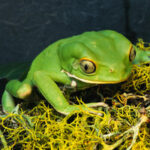The Lucky Money Frog, Ch’an Chu, is an interesting little guy. Anthropologist Ostowari explained him as, “the relative who is in every family picture, but whose name no one knows.” He can be spotted in homes and businesses, up high on a shelf or down beneath a chair. However, it is more likely that you will find him for sale rather than in use.
Speaking of sales, the purchase of the frog itself is an interesting story. We were out shopping for Christmas presents when we spotted Lan Lan’s shop. My mother was peering around the store when she noticed this frog sitting on the floor. Not realizing his cultural significance, my mother’s natural inclination (as with all mothers) was to pick him up off the floor and place him in a more appropriate spot (in this case, a shelf). The very instant my mother moved the frog, the shop owner came tumbling forward from behind the counter, repeating in upset, “This brings good luck!”, and “He must be placed facing this way!”
That was some kind of marketing strategy, because after that my mother and sister were bent on buying it. After the purchase was made and my family headed back to the car, they realized that the coin was missing from his mouth. Before they even had a chance to make their way back to the store, the shopkeeper came out, running with coin-in-hand, yelling, “You need this! Real money! Good luck!” It’s funny the way two different cultures could have an entirely different outlook on one particular object.
In comparison with the Lucky Horseshoe, the reverence and importance of placement given to Ch’an Chu is quite different. The Lucky Horshoe, which originated in Europe, is symbolic of the moon goddesses Artemis and Diana. While Ch’an Chu is meant to be placed indoors and in relatively hidden places, the Lucky Horshoe is generally hung above or next to doorways. Even today, you can still find them nailed onto houses, barns, and stables from Italy through Germany and up into Britain and Scandinavia. Unlike Ch’an Chu, there is uncertainty when it comes to how the Lucky Horseshoe should be placed. According to Cat Ywonrode of the Amulet Archives, “Americans of English and Irish descent prefer to display horseshoes upward; those of German, Austrian, Italian, Spanish, and Balkan descent generally hang them downward.” You would not find this problem with the Chinese– they know exactly why and where Ch’an Chu should be placed.
The Lucky Money Frog has many meanings for the Chinese. Symbolically speaking, it is the embodiment of the yin concept, the immortal moon goddess. The moon goddess is what gives Ch’an Chu its form, and the lunar symbols such as the gems on his back (which resemble the dipper) and his three legs (which represent three lunar phases). And according to tradition, during a full moon the king money frog will appear near houses in which good news will soon be received. The ancient round I-Ching coins are also an important part of this tradition, and Anjian Australia Feng-Shui experts claim that the “ancient Chinese coins have been used for centuries as amulets to ward off evil and disease.”
In Feng-Shui, the Lucky Money Frog is an extremely popular symbol of wealth. According to Werner’s Dictionary of Chinese Mythology, Feng-Shui is “the art of adapting the residence of the living and the dead so as to cooperate and harmonize with the local currents of the cosmic breath (the yin and yang)” and a vital part of ancient Chinese mysticism. Not only does he attract wealth and provide monetary protection, the Lucky Money Frog will also rid you of any bad luck that might be causing monetary difficulties.
Due to the uniqueness of its powers and symbolism, the king money frog can help with solving any money related problems– as long as you know where to put him. He should be placed on your floor inside your front door facing inward or in the corner diagonally opposite of your front door, as this symbolizes money coming into your home. However, do not place him facing towards your door, as this represents money leaving your home. The coin in his mouth is also, in effect, calling out to other coins… so don’t misplace it.
What makes the Lucky Money Frog so unique is his significance in modern times. When the most common thought would be to go out and make your own money, the Lucky Money Frog engages the ancient world instead, using symbols to attract wealth. Ostowari put it perfectly: “It is a mix of ‘ancient’ Chinese luck combined with Americanized capital fortune and expectations; thus, we have the Money Frog, Ch’an Chu, with a coin in its mouth– a combination of the ancient symbol and the modern world.”
References
Werner, E.T.C., A Dictionary of Chinese Mythology. New York, NY: Julien, 1961.
Anjian Australia. I-Ching Coins. 2002. 15 Oct. 2006
(http://www.anjian.com.au/productpages/iching/iching.html)
Learn About Feng Shui. “Money Frogs.” 15 Oct. 2006
(http://learnaboutfengshui.com/shopping/index.php?main_page=index%cPath=15). – Page no longer available.
Jelling, Jakob. “The mythical king money frog.” 13 Oct. 2006
(http://www.fengshuicrazy.com/business-wealth/the-mythical-king-money-frog.php).
Amy Horwitz, Dan Learned, Ivan Ortiz, Lisa Dooley, Alexandria Ostowari. “Ch’an Chu: The Lucky Money Toad.” 13 Oct. 2006
(http://www.anthro.uci.edu/html/Programs/Anthro_Money/ChanChu.htm).
Cat Ywonrode. “The Horshoe.” 2003. 13 Oct. 2006
(http://www.luckymojo.com/horseshoe.html).




